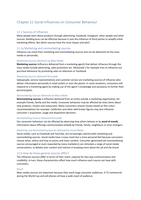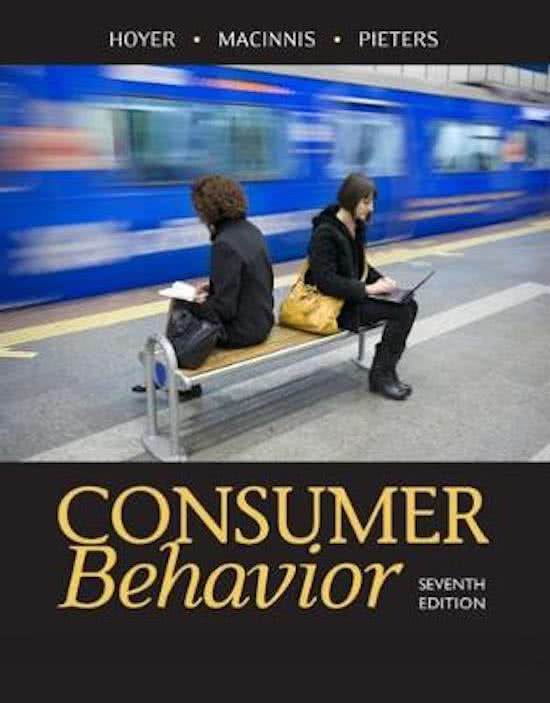Chapter 11 Social Influences on Consumer Behaviour
11.1 Sources of Influence
Many people learn about products through advertising, Facebook, Instagram, other people and other
sources. Building buzz can be effective because it uses the influence of third parties to amplify initial
marketing efforts. But which sources have the most impact and why?
11.1a Marketing and nonmarketing sources
Influence can come from marketing and nonmarketing sources and can be delivered via the mass
media or personally.
Marketing Sources Delivered via Mass Media
Marketing sources (influence delivered from a marketing agent) that deliver influence through the
mass media include advertising, sales promotion etc. McDonald’s for example tries to influence our
purchase behaviour by promoting sales on television or Facebook.
Marketing Sources Delivered Personally
Salespeople, service representatives and customer service are marketing sources of influence who
deliver information personally in retail outlets or over the phone. In some situations, consumers will
respond to a marketing agent by making use of the agent’s knowledge and assistance to further their
personal goals.
Nonmarketing Sources Delivered via Mass Media
Nonmarketing sources is influence delivered from an entity outside a marketing organization, for
example friends, family and the media. Consumer behaviour may be affected by news items about
new products, movies and restaurants. Many consumers choose movies based on film critics’
recommendations for example. Celebrities and other well-known figures may also influence
consumer’s acquisition, usage and disposition decisions.
Nonmarketing Sources Delivered Personally
Our consumer behaviour can be affected by observing how others behave or by word of mouth,
information about offerings communicated verbally by friends, family, neighbours or even strangers.
Marketing and Nonmarketing Sources Delivered by Social Media
Social media, such as Facebook and YouTube, are increasingly used by both marketing and
nonmarketing sources. Social media have a mass reach but a more personal feel because consumers
choose when, where and how to access and share content. Consumer-generated ads (nonmarketing
sources encouraged or even rewarded by many marketers) can stimulate a range of social media
conversations, to debate over content and interest in knowing more about the ad and the brand.
11.b How do these general sources differ?
The influence sources differ in terms of their reach, capacity for two-way communication and
credibility. In turn, these characteristics affect how much influence each source can have with
consumers.
Reach
Mass media sources are important because they reach large consumer audiences. A TV commercial
during the World Cup and cell phones all have a wide reach of audience.
,Capacity for Two-Way Communication
Personally delivered sources of influence are valuable because they allow for a two-way flow of
information. Personal conversations are often more causal and less purposeful than mass media –
delivered information. Information from a personal source may also seem more vivid than
information from the mass media because the person speaking somehow makes it more real, a
factor that may make it more persuasive.
Credibility
While personal and mass media sources differ in their reach and capacity for two-way
communication, marketing and nonmarketing sources differ in their credibility. Consumers tend to
perceive information delivered through marketing sources as being less credible, more biased and
manipulative. In contrast, nonmarketing sources appear more credible because we do not believe
that they have a personal stake in our purchase, consumption or disposition decisions. We also tend
to believe information that we hear from people with who we have close relationships. In part
because their similarity to us make their opinions more credible. Certain people are also regarded as
more credible than others because they are experts or are generally recognized as having unbiased
opinions.
11.1c Opinion leaders
A special source of social influence is the opinion leader, someone who acts as an information broker
between the mass media and the opinions and behaviours of an individual or group. Opinion leaders
have some position, expertise or first-hand knowledge that makes them particularly important
sources of relevant and credible information, usually in a specific domain or product category.
Opinion leaders are regarded as nonmarketing sources of influence, a perception that adds to their
credibility. They are not necessarily well-known people. Opinion leaders are part of a general
category of gatekeepers, people who have special influence or power in deciding whether a product
or information will be disseminated to a market.
Opinion leaders have influence because they generally have no personal stake in whether their
opinions are heeded, so their opinions are perceived as unbiased and credible. They are also
regarded as knowledgeable about acquisition, usage and disposition options because of their product
knowledge and experience. Opinion leaders often get information by seeking it from consumers,
manufactures and retailers. A market maven is a consumer on whom others rely for information
about the marketplace in general. He/she seems to know all about the best products, the good sales
and the best stores or retail websites.
11.2 Reference Groups as Sources of Influence
A reference group is a set of people with whom individuals compare themselves for guidance in
developing their own attitudes, knowledge and/or behaviours.
11.2a Types of reference groups
Consumers may relate to three types of reference groups: aspirational, associative and dissociative.
Aspirational reference groups are group we admire and wish to be like but are not currently a
member of. Associative reference groups are groups to which we actually belong, such as a clique of
friends or a club. Associative reference groups can form around a brand. A brand community is a
specialized group of consumers with a structured set of relationships involving a particular brand,
fellow customers of that brand and the product in use. Dissociative reference groups are groups
whose attitudes, values and behaviours we disapprove of and do not wish to emulate.
, 11.2b Characteristics of reference groups
Reference groups can be described according to the degree of contact, formality, similarity among
members, group attractiveness, density, degree of identification and strength of the ties connecting
members.
Degree of contact
Reference groups vary in their degree of contact. We may have direct and extensive contact with
some reference groups like our immediate circle of friends or family but may have less contact with
others like politicians. A group with which we have face-to-face interaction, such as family, is a
primary group. In contract, a secondary reference group is one that may influence us even though
we have no personal contact with most of its members.
Formality
Reference groups also vary in formality. Groups like clubs and classes are formally structured, with
rules outlining the criteria for group membership and the expected behaviour of members. Other
groups are more ad hoc, less organized and less structured.
Group Attractiveness
When members perceive a group as being very attractive, they have stronger intentions to conform
to what the group does – even its illicit consumption behaviour.
Density
Dense groups are those in which group members all know one another. In many countries, network
density varies by geographic area.
Degree of Identification
Just because people are members of a group does not mean that they use it as a reference group.
The influence that a group has on an individual’s behaviour is affected by the extent to which he or
she identifies with it.
Tie-Strength
Tie-strength is the extent to which a close, intimate relationship connects people.
11.2c Reference groups affect consumer socialization
One way that reference groups influence consumer behaviour is through socialization, the process by
which individuals acquire the skills, knowledge, values and attitudes that are relevant for functioning
in a given domain. Consumer socialization is the process by which we learn to become consumers
and come to know the value of money. Through socialization, consumers learn consumption vales as
well as gain the knowledge and skills for consumption. It can occur in many ways.
People as Socializing Agents
Reference groups like family and friends play an important role as socializing agents.
Intergenerational influence – information, beliefs and resources being transmitted from one
generation to the next – affects consumers’ acquisition and use of certain product categories and
preferred brands. Moreover, parents affect socialization by influencing what types of products, TV
programs, and ads their children are exposed to and how much control they have over buying
products that they want. The effect of reference groups as socializing agents can change over time,
socialization is a life-long process.
The Media and the Marketplace as Socializing Agents
TV programs, movies and videos, music, video games, the Internet and ads can also serve as
socializing agents.






